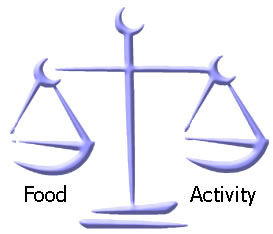Do Public Health Professionals Need To Brush Up Their Knowledge of Basic Science?
 In a thoughtful paper published in BMC Medicine, Katherine Hafekost and colleagues from the University of Western Australia propose that the main reason why we have yet to see effective public health intervention to sustainably reduce obesity is because the champions of these policies largely ignore the basic scientific facts of human physiology.
In a thoughtful paper published in BMC Medicine, Katherine Hafekost and colleagues from the University of Western Australia propose that the main reason why we have yet to see effective public health intervention to sustainably reduce obesity is because the champions of these policies largely ignore the basic scientific facts of human physiology.
Based on their systematic analysis of 27 article published in 2011 proposing public health interventions for obesity, the researchers found that all of these were based on a rather simplistic notion of energy balance. Despite acknowledging the complexity of obesity, the underlying philosophy of these public health approaches was essentially built around the idea that reducing caloric intake (diet) and increasing caloric expenditure (exercise) would result in long-term sustainable negative energy balance and thus result in a lower body weight.
As the authors note,
“Almost all the identified interventions focused on reducing energy intake, increasing physical activity, and reducing sedentary behaviors underpinned by an energy-balance model assuming independence between energy intake and expenditure, with little consideration of homeostatic feedback mechanisms.”
“Research from the fields of biochemistry and human physiology, which provides a more detailed model of energy balance, offers some insight into why many weight-loss interventions have little long-term success and poor program adherence….Although in the short term, food intake and energy expenditure are often influenced by situational factors, over longer time periods numerous neural and hormonal mechanisms operateto regulate body weight. Restrictions in caloric intake and/or increases in physical activity are likely to be matched by behavioral, metabolic, neuroendocrine, and autonomic changes that will limit long-term success.”
Given that body weight is tightly regulated and that our bodies will always “defend” against body weight loss, the best that public health measures can hope to achieve is to prevent further weight gain – they do not and cannot offer sustainable weight-loss.
“The failure of research in the field of public health to incorporate the concept of homeostatic feedback mechanisms into interventions is reflected in the current dietary guidelines, public health policy, and population-wide interventions aimed at targeting overweight and obesity.”
Although public health messages to eat healthier diets and reduce sedentariness no doubt have important cardiovascular and other benefits, when explicitly promoting reduced energy consumption and increased expenditure as the appropriate means by which to achieve weight loss, such measures pose ethical challenges.
“Despite the extensive literature on their long-term ineffectiveness, interventions based on this simplistic understanding of energy balance continue to be advocated under the assumption that previous interventions have not been pursued sufficiently vigorously or that participants have failed to follow the prescriptions of the intervention.”
“Continuing to promote a model that is unlikely to be successful in the longer term, and may result in individuals becoming discouraged, is both unproductive and wasteful of resources that could be better spent on investigating more plausible alternatives to improving weight control.”
I would add that the “energy-centric” model of obesity reduction not only fails to acknowledge the powerful homeostatic defences agains sustained weight loss but also generally fails to address the powerful psycho-biological drivers of weight gain.
Unfortunately, despite first eloquently arguing against overly simplistic “energy-balance” models of obesity interventions, the authors astonishingly still suggest that,
“The focus of future public health research should be on the development of large scale, long-term prospective studies that test dietary and exercise protocols that have been shown to be beneficial to weight loss and maintenance.”
I disagree! Enough effort and money has been spent on this.
I would much rather support their other recommendation, namely,
“..ensuring that funding or grant panels considering proposals for future intervention research include members trained in human biochemistry and physiology as well as public health advocates. This may assist in the development and implementation of appropriate research designs and methods that are underpinned by a complex model of energy balance.”
I also concur with the authors that, while,
“Currently, most research seems to address the question of what factors lead people to eat too much and exercise too little.”,
“Developing and testing interventions that are based on biologically plausible mechanisms [would be] an important step forward in developing effective interventions to combat obesity and its associated metabolic diseases.”
@DrSharma
Edmonton, AB
Hat tip to Cindy for pointing me to this paper.
![]()
Hafekost K, Lawrence D, Mitrou F, O’Sullivan TA, & Zubrick SR (2013). Tackling overweight and obesity: does the public health message match the science? BMC medicine, 11 PMID: 23414295
.
Do Public Health Messages Promote Weight Bias?
 Regular readers may recall previous posts asking whether well-meant public health messages in response to the obesity epidemic could in fact promote weight bias, thereby causing more harm than good (at least amongst the intended audience).
Regular readers may recall previous posts asking whether well-meant public health messages in response to the obesity epidemic could in fact promote weight bias, thereby causing more harm than good (at least amongst the intended audience).
This question has now been scientifically addressed by Rebecca Puhl and colleagues from Yale University’s Rudd Centre for Food Policy, in a paper published in the International Journal of Obesity.
Puhl and colleagues collected online data from a nationally representative sample of 1014 adults, who were shown a random selection of 10 (from a total of 30) messages from major obesity public health campaigns from the United States, the United Kingdom and Australia, and were asked to rate each campaign message according to positive and negative descriptors, including whether it was stigmatizing or motivating.
Participants responded most favourably to messages that were perceived to be most positive and motivating and which made no mention of the word ‘obesity’ at all, instead focusing on making healthy behavioral changes without reference to body weight.
Participants also responded favorably to messages involving themes of increased fruit and vegetable consumption, and general messages involving multiple health behaviors.
In contrast, messages that have been publicly criticized for their stigmatizing content (such as ‘Childhood obesity is child abuse.’, ‘Too much screen time, too much kid.’ and ‘Being fat takes the fun out of being a kid.’) received the most negative ratings and the lowest intentions to comply with message content.
There were also important differences on how people of different weights perceived the stigmatizing nature of these messages:
Thus, compared to non-obese participants, obese participants perceived messages like, ‘Skip seconds…Lose your gut.’, ‘You have the strength to take control of your health.’, or ‘The temptation to eat unhealthy food is hard to fight, but it’s a fight that you and your community can win.’ as significantly more stigmatizing.
As the authors point out,
“Despite widespread prejudice induced by societal weight stigmatization, there nevertheless remains a perception that stigmatizing obese persons will instill motivation to engage in healthier lifestyles or is necessary to raise public awareness about the seriousness of obesity….Although this perception may be common, considerable evidence demonstrates that individuals who feel stigmatized or shamed about their excess weight engage in higher calorie intake, unhealthy eating behaviors, binge-eating patterns, as well as avoidance of exercise,which can reinforce weight gain and impair weight loss. Thus, public health campaigns that communicate stigmatizing, shameful messages could inadvertently make the problem worse and harm those most in need of help.”
Given that the responses to messages were most positive, when there was no mention of body weight, the authors further suggest that,
“…making reference to obesity itself may not be necessary to instill motivation amongst most people who may feel more motivated to comply with message content that emphasizes health behaviors rather than body weight. Given that increased nutrition and physical activity are important for all segments of the population, these messages could have a broader reach to the American population when weight-related language is absent.”
Not surprisingly, the authors also conclude that it may in fact be a good idea to test messages on how they are perceived, especially by people with excess weight, prior to initiation of any public messaging campaigns.
Clearly it may be better if public health messages, as a rule, promoted ‘healthy lives’ rather than ‘healthy weights’.
If you have been inadvertently affected, irritated or offended by public health messages, I’d certainly love to hear from you.
AMS
Edmonton, Alberta
![]()
Puhl R, Peterson JL, & Luedicke J (2012). Fighting obesity or obese persons? Public perceptions of obesity-related health messages. International journal of obesity (2005) PMID: 22964792
.
Impact of BMI on Health Status, Hospitalizations, Day Procedures, and Physician Costs
 While in individuals BMI may not be the best measure of obesity (or health), in population studies, it does serve as a reliable indicator of the ‘burden’ of overweight and underweight.
While in individuals BMI may not be the best measure of obesity (or health), in population studies, it does serve as a reliable indicator of the ‘burden’ of overweight and underweight.
In a paper by Jean-Eric Tarride (McMaster University) that we just published in ClinicoEconomic and Outcomes Research, we examine data from all Ontarians who participated in the Canadian Community Health Survey (CCHS), cycle 1.1 and provided consent to data linkage were linked to three administrative databases.
Obese adults, and to a lesser extent overweight adults (together about 50% of the population), were more likely to report physician-diagnosed comorbid conditions, to use medications, and to have a lower health-related quality of life.
After adjustment for for personal income, smoking status, physical activity status, age and gender, the hospitalization and physician costs were respectively 40% and 22% higher among obese and overweight adults than among normal-weight adults.
No statistical cost differences were observed between normal and underweight individuals or between normal and overweight individuals.
On the other hand, health-related quality of life was significantly lower in both the underweight and obese adults when compared to normal-weight individuals.
With regard to the excess costs associated with obesity, these were not equally distributed between the genders – surprisingly enough, overall obese men did not appear to incur higher medical costs in this analysis.
In contrast,
“women had significantly higher physician, day procedure and hospitalization costs than men once a cost has been incurred. In addition, women had a higher probability of being hospitalized or undergoing a day procedure than men.”
Thus, we suggest that obesity programs targeted towards women may have greater potential for reducing costs associated with hospitalization, day procedures, and physicians.
Similarly, increased costs were not equally distributed across age groups – the greatest cost difference were seen in the 40–59 year old age group.
This finding suggests that obesity programs should perhaps focus their interventions on middle-aged obese individuals, which also suggests that the workplace may be the most practical environment for the implementation of such programs.
In this paper, we also point out that,
“…BMI does not truly reflect the burden of obesity-related health risks. Thus, as recently demonstrated in several large US population samples,26,27 the Edmonton Obesity Staging System (EOSS), which classified overweight and obese individuals on a 5-point ordinal scale based on the presence of medical, mental and/or functional comorbidities, strongly predicted mortality, whereas BMI did not. Importantly, in this analysis, a considerable proportion (about 50%) of individuals in the overweight range presented with obesity-related health problems (EOSS >1), while a substantial number (about 30%) of individuals with BMI >30 had no obesity-related health risks.”
It is also important to note that this paper did not look at all of the health care costs related to obesity – there were no data for medication cost or other health care costs that may have been incurred by participants – it is very likely that these costs will also be higher in obese people with associated health problems.
Reason enough to hope that with better obesity prevention and/or treatment efforts, some of these excess costs could be reduced – however, that of course, remains to be seen, as neither obesity prevention nor treatment are likely to be cheap. So far, cost savings with obesity treatment have only been shown for bariatric surgery in patients with significant health problems like diabetes (EOSS 2+).
AMS
Edmonton, Alberta
![]() Tarride JE, Haq M, Taylor VH, Sharma AM, Nakhai-Pour HR, O’Reilly D, Xie F, Dolovich L, & Goeree R (2012). Health status, hospitalizations, day procedures, and physician costs associated with body mass index (BMI) levels in Ontario, Canada. ClinicoEconomics and outcomes research : CEOR, 4, 21-30 PMID: 22347802
Tarride JE, Haq M, Taylor VH, Sharma AM, Nakhai-Pour HR, O’Reilly D, Xie F, Dolovich L, & Goeree R (2012). Health status, hospitalizations, day procedures, and physician costs associated with body mass index (BMI) levels in Ontario, Canada. ClinicoEconomics and outcomes research : CEOR, 4, 21-30 PMID: 22347802
.
Childhood Predictors of Adult Obesity
 There are good reasons to believe that for a significant number of people, the foundations of adult obesity may well be established in early childhood or even in utero.
There are good reasons to believe that for a significant number of people, the foundations of adult obesity may well be established in early childhood or even in utero.
This topic is the focus of an extensive review by Tristin Brisbois and colleagues from the University of Alberta, just published in OBESITY REVIEWS.
In their paper, the researchers screen the literature on data supporting a role for a wide range of factors in early childhood (≤5 years of age) that potentially predict the development of obesity in adulthood.
Factors of interest included exposures/insults in the prenatal period, infancy and early childhood, as well as other socio-demographic variables such as socioeconomic status (SES) or birth place that could impact all three time periods.
Their review of over 8,000 citations, resulted in relevant 135 studies, which reported a total of 42 variables as being associated with obesity in adulthood.
Of these, however, only seven variables made the cut as potential early markers of obesity.
These included maternal smoking and maternal weight gain during pregnancy, maternal body mass index, childhood growth patterns (early rapid growth and early adiposity rebound), childhood obesity and father’s employment (a proxy measure for SES in many studies).
Notably, neither early childhood nutrition or physical activity were identified as possible predictors.
Although such association studies alone by no means imply causality, the identified variables are nevertheless worth considering as reasonable targets in the development of health promotion programmes to reduce the risk of adult obesity. Clearly, the feasibility and effectiveness of such measures remains to be demonstrated.
AMS
Dallas, TX
![]() Brisbois TD, Farmer AP, & McCargar LJ (2011). Early markers of adult obesity: a review. Obesity reviews : an official journal of the International Association for the Study of Obesity PMID: 22171945
Brisbois TD, Farmer AP, & McCargar LJ (2011). Early markers of adult obesity: a review. Obesity reviews : an official journal of the International Association for the Study of Obesity PMID: 22171945
.
.
Sobering Dieting Advice From the Quebec Public Health Agency
 One of the brochures that was freely distributed at the recent Journées annuelles de santé publique (Québec) meeting I spoke at yesterday in Montreal, is a pamphlet produced by the Québec Public Health Agency (with funding from the Public Health Agency of Canada) on the potential risks of dieting.
One of the brochures that was freely distributed at the recent Journées annuelles de santé publique (Québec) meeting I spoke at yesterday in Montreal, is a pamphlet produced by the Québec Public Health Agency (with funding from the Public Health Agency of Canada) on the potential risks of dieting.
The pamphlet notes that:
• 1 woman out of 2 in Quebec wants to lose weight
• 45% of children aged 9 in Quebec aren’t happy with their figure
• Half of Quebec women try dieting more than twice a year
• Losing weight does not mean you are healthier (quite the statement coming from a public health agency)
• Many women mistakenly believe losing weight will improve their self-esteem, make them more attractive and make them sexier.
The pamphlet actually warns that:
“Always being on a diet might make you gain weight. The more you are preoccupied with your weight, the more you are at risk of suffering from depression and stress. Day-to-day activities like meals, getting dressed and playing sports can be transformed into major sources of anxiety.”
The pamphlet is also very clear about why most commercial diets don’t work:
Diets don’t take into account the reasons why you are gaining weight:
• Heredity, disease, medication, age, etc.
• Eating habits, physical activity, being obsessed with one’s own weight, etc.
• Perfectionism, low self-esteem, anxiety, stress, etc.
• Standards of beauty, the environment, the type of work we do, etc.
Finally, it offers the following points to consider when thinking about losing weight:
- Weight-loss pace: Does my plan focus on losing more than 1-2 pounds per week?
- Methods used: Does my plan focus on what food I eat, physical activity and changing my habits?
- Is health professional support available?
- Food intervention: Do you vary the meals you make, experiment with different flavours, colours and ingredients? Eating right is good for your health but it can also be fun and delicious!
- Physical activity: Does my plan have an element of physical activity, the kind I enjoy?
- Efficiency: Has the approach I am taking been scientifically verified, and is it efficient over the long term?
- Danger: Is my plan safe, meaning is it devoid of danger and secondary effects?
- Advertising: Are the ads related to my plan realistic?
- What it costs: Can I realistically evaluate the total cost of my plan?
The brochure is available both in French and English.
Not sure that warning about the ‘dangers of weight loss’ is standard practice with other public health agencies – I certainly haven’t seen similar warning signs in other jurisdictions.
Obviously, the Agency is by no means implying that excess weight or obesity cannot be a health problem – it is simply warning about the possibility that ‘self-guided’ non-evidence-based approaches, especially those often promoted by the commercial weight-loss industry, may in the end do more harm than good.
When weight loss is indeed medically indicated – treatment should perhaps be best left to ‘qualified‘ health professionals.
AMS
Toronto, Ontario
p.s. Hat tip to Chantal Bayard of the ASPQ for bringing these brochures to my attention


